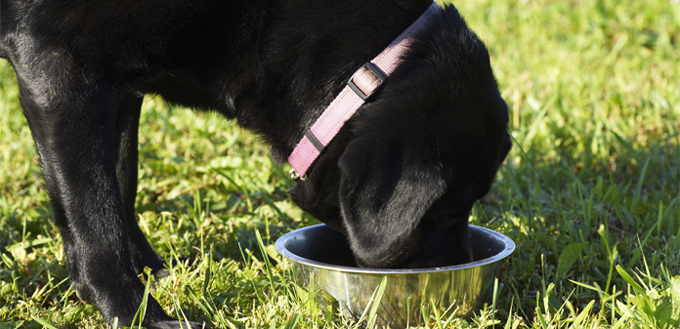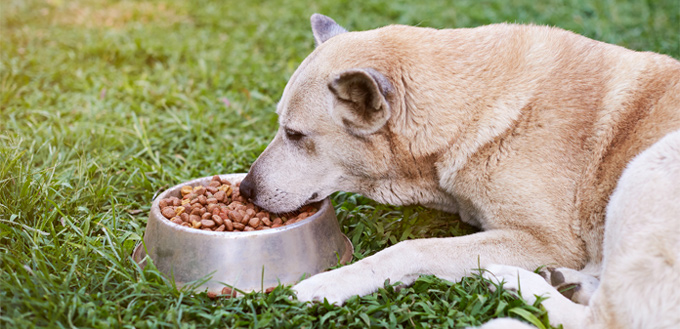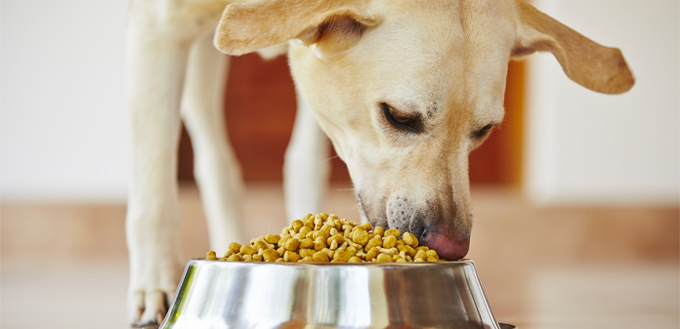From Great Danes to Yorkshire Terriers, most dogs will have the occasional upset stomach – that’s where bland diets come in. If your canine companion experiences a bout of diarrhoea or vomiting, feeding them a bland diet for a few days can help to resolve the issue. This kind of diet consists of simple, easily digestible ingredients, which allow the digestive tract a break, giving your pooch’s system time to right itself. It’s important to administer a bland diet carefully, and take your dog straight to the vet if the upset stomach comes with other symptoms, or doesn’t sort itself out after a few days. Below we outline exactly when, and how, you can safely administer a bland diet to your dog.

When to Consider a Bland Diet
Bland diets can be used to treat mild cases of vomiting and diarrhoea in dogs. Ideally, you should have some idea about what might have caused the stomach upset. This could be a number of things including:
- Your pet eating something they perhaps shouldn’t have
- Transitioning to a new diet
- A significant change, such as moving home
- A long car journey, which can result in motion sickness for some animals
- Medication – particularly antibiotics
A light diet, with very little fat, will ease the strain on your furry friend’s stomach, and help them get back to normal. This guide on the best dog food for sensitive stomachs may come in handy when choosing food for your lovely pet.
Fasting Your Dog
Before starting to feed your dog a bland diet, they should be fasted for a short period. For adult dogs, fasting should last for between 12 and 24 hours. Puppies should only be fasted for six to 12 hours.
Fasting helps to settle your dog’s stomach in two main ways:
- Easing pressure on the digestive system
When your dog fasts, their intestinal system is able to relax, easing the strain and discomfort caused by digestive issues.
- Reducing acid production
Without the stimulation of food intake, acid secretions are reduced. With less acid in your dog’s digestive tract, irritation will be eased.
During the fasting period, make sure to keep your dog hydrated by offering them small amounts of water or ice chips at regular intervals. Diarrhea is a particularly nasty culprit for dehydration, so this step is really important.
Dehydrated dogs often lose their appetite, which might be misleading when you are trying to wean them back onto food. You can tell your dog is dehydrated if:
- They become lethargic
- They pant
- Their eyes appear sunken
- Their nose and gums are dry
- Their skin loses its elasticity (you can check this by gently pinching your dog’s skin – in well-hydrated dogs, it will quickly spring back to its original position)
When no diarrhea has occurred for around six hours, you can begin to feed your dog the bland diet. If your dog has been vomiting, you should them with a teaspoonful of food before starting the bland diet. If they manage to keep down this small amount of food, they are probably ready for it, if not, they should be fasted for a little longer.
Related Post: Dog Water Fountain
Feeding Intervals
Little and often is the name of the game when administering a bland diet. As you would expect, smaller volumes of food are easier to digest, but they need to be provided regularly to meet your dog’s caloric needs.
The initial serving size should be around a quarter of what your dog would usually be fed, given to them every six to eight hours. Continue feeding your dog in this manner for four to five days, until their stool begins to be firm again. It might be tempting to give your dog treat when they’re feeling under the weather, but this is best avoided since they can be harder to digest, and disrupt the effectiveness of a bland diet. Instead, plenty of gentle tummy rubs and ear scratches will be greatly appreciated as your friend recovers!
Getting Back to Normal
It’s important to make a gradual transition when it comes to weaning your dog back onto their regular diet. Most vets recommend making the change over the course of a week: First of all, mix a meal for your dog which is roughly three quarters bland food, and one quarter regular diet. Feed your pet in this way for two days; if they continue to feel brighter, replace another quarter of bland food with regular food every two days, until things are back to normal.
Avoiding fast dietary change helps to ensure that your dog does not develop new digestive issues. When your dog is back on their usual diet, they should not be given many extra treats for the first week.
Using Bland Diets Safely
The most important thing to remember about bland diets is that they don’t provide your dog with every nutrient they need. This type of food is a stripped-back version of what your dog would usually eat, and a number of vital nutrients – including vitamin D, vitamin A, and folic acid – are largely absent from most traditional bland diet recipes. You shouldn’t feed your pet a bland diet for any longer than two weeks, or a few days for puppies since their bodies are still developing. It is a good idea to visit your vet quickly if a puppy experiences diarrhoea or frequent vomiting, since they are more at risk of dehydration than adult dogs. Finally, it is worth mentioning that diabetic dogs should not be fasted, as this can be extremely dangerous. Consult your vet before making any changes to the diet of a diabetic dog. For a wider selection of choices, check out our diabetic dog food guide.

In short, bland diets should only be used to treat mild cases. If your dog is exhibiting other symptoms, such as bloody stool, fever, or more severe vomiting or diarrhea, it’s best to take them to the vet rather than using a home remedy.
Recipes to Try
Every dog’s tastes are different, but fortunately there are plenty of bland diet options to choose from. Luckily, most are very easy to prepare!
- Rice and hamburger bland diet
This is perhaps the most widely used bland diet. To prepare it, boil white rice and lean hamburger meat in separate pots, before combining. Boiling the meat allows you to avoid adding extra fat to the meal, making the meal even easier on a dog’s stomach. The ideal ratio for this recipe is four parts rice to one part meat.
- Chicken and rice bland diet
This staple for humans can also be enjoyed by our lupine pals. Boil the rice and chicken separately until both are very tender, and mix in a ratio of one part chicken for every three parts rice. To make this dish even easier to digest, it is a good idea to chop the chicken into very fine strips, and mix in thoroughly with the rice.
- Turkey and pumpkin bland diet
If your dog doesn’t handle grains well, this pumpkin be a great alternative to rice. To prepare this dish, cook lean ground turkey (cooking helps to remove more fat) and mix with plain canned pumpkin in a one to one ratio.
- Plain scrambled eggs
If you don’t have any meat on hand, there are plenty of alternative bland diets – one such alternative is simple scrambled eggs. Whisk and cook them without adding milk or butter, to keep the meal low in fat. Cooking the eggs in a microwave could be your best option, as they might stick to the bottom of a saucepan without butter.
- Cottage cheese bland diet
Since cottage cheese is high in protein, low in fat, and easy to digest, it is another great option for bland diets. Cottage cheese can be mixed with cooked white rice in a ratio of two parts rice to one part cheese. Since many dogs love cheese, this could be a nice treat for pets who are under the weather.

To Sum Up
Overall, bland diets can be an easy and effective solution when your dog has an upset stomach. With light food, plenty of water, and rest, your dog could well be back to their old self within a few days. The key to using bland diets successfully is to keep a careful eye on your pet. More severe symptoms should be addressed by a veterinary professional as soon as possible, and if your dog has an underlying health condition you should consult them before attempting such a big dietary change.
Sources:
- Anna Burke, Five Foods to Feed Your Dog When He’s Sick, The American Kennel Club
- Dog Nutrition Tips, ASPCA
- Meatless Meals for Dogs and Cats, PETA







